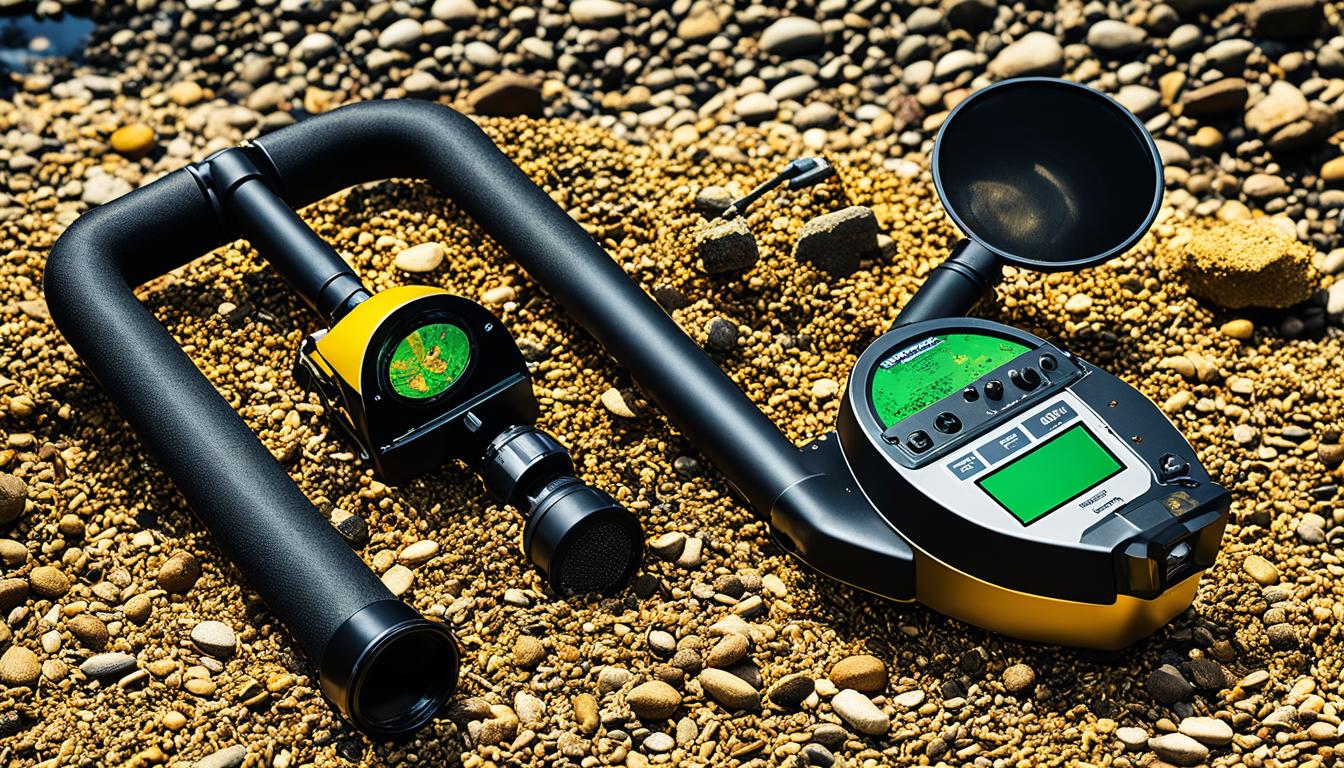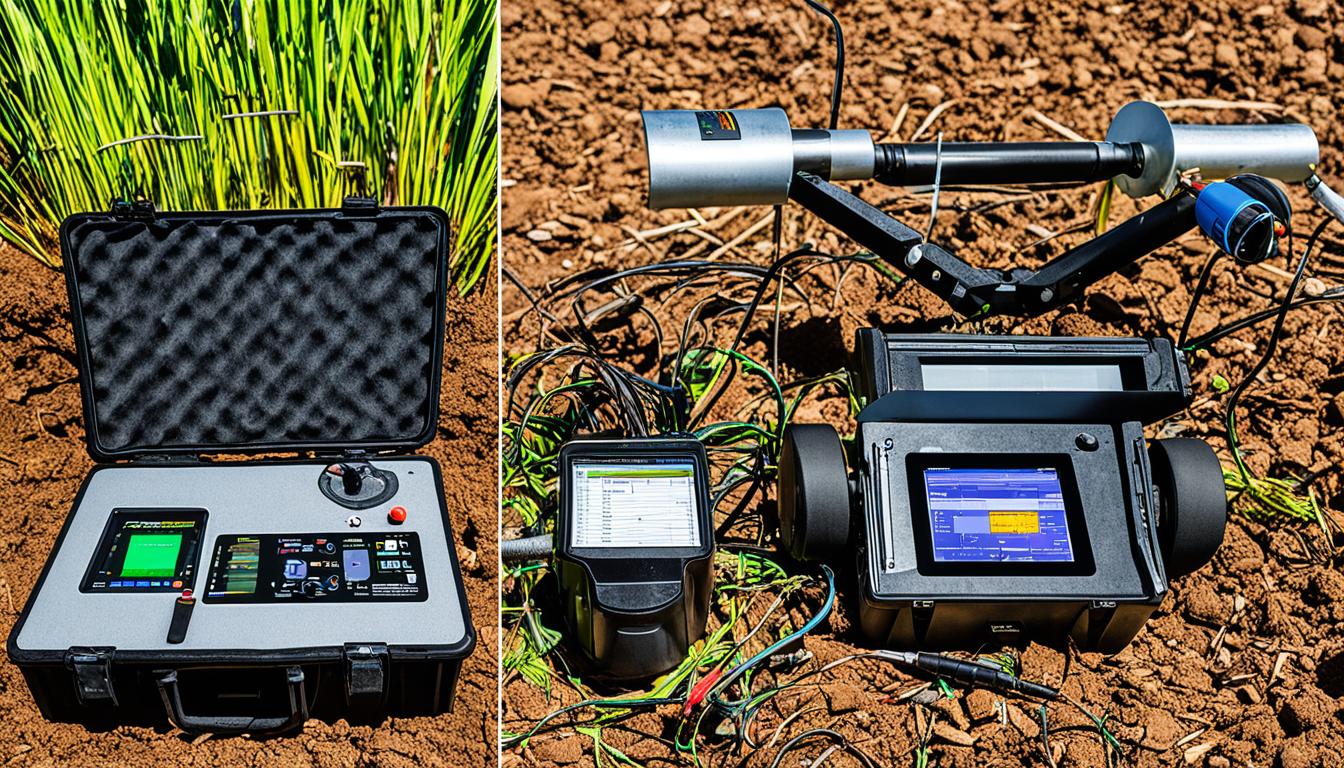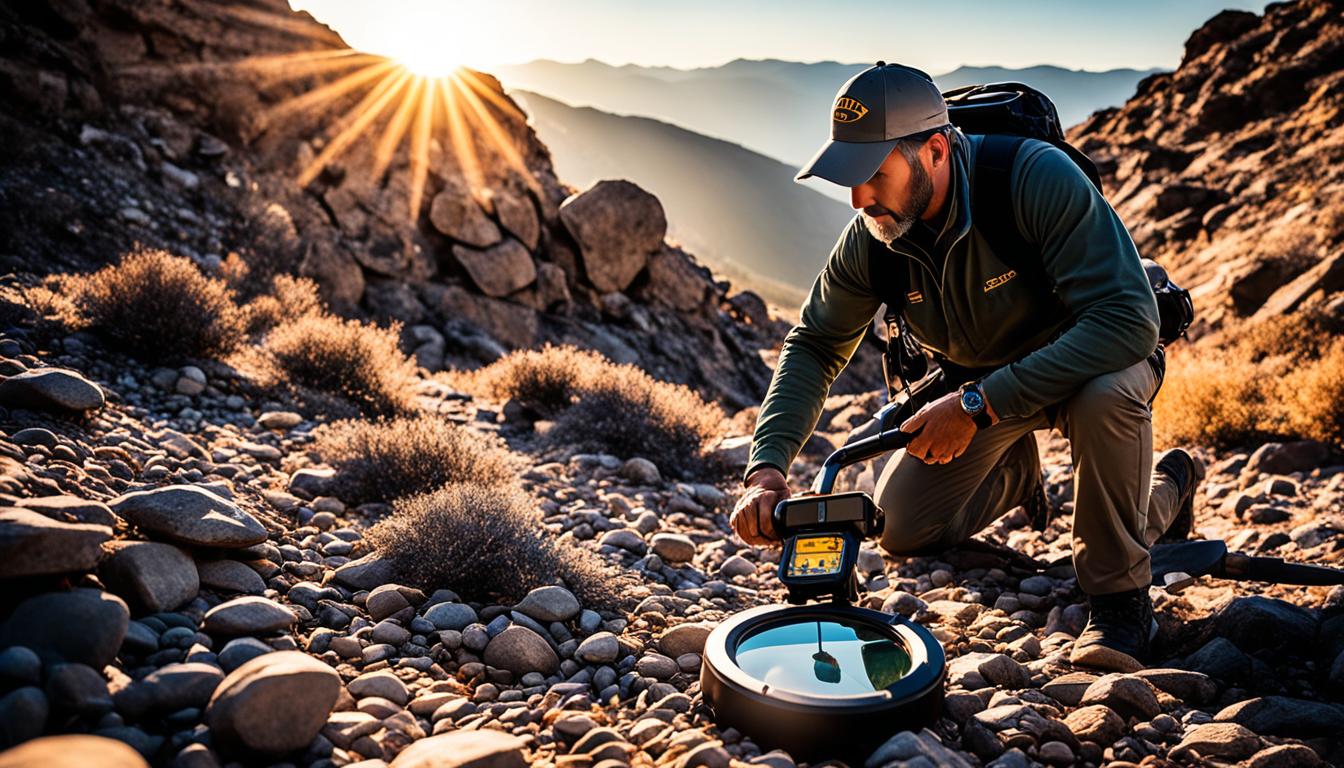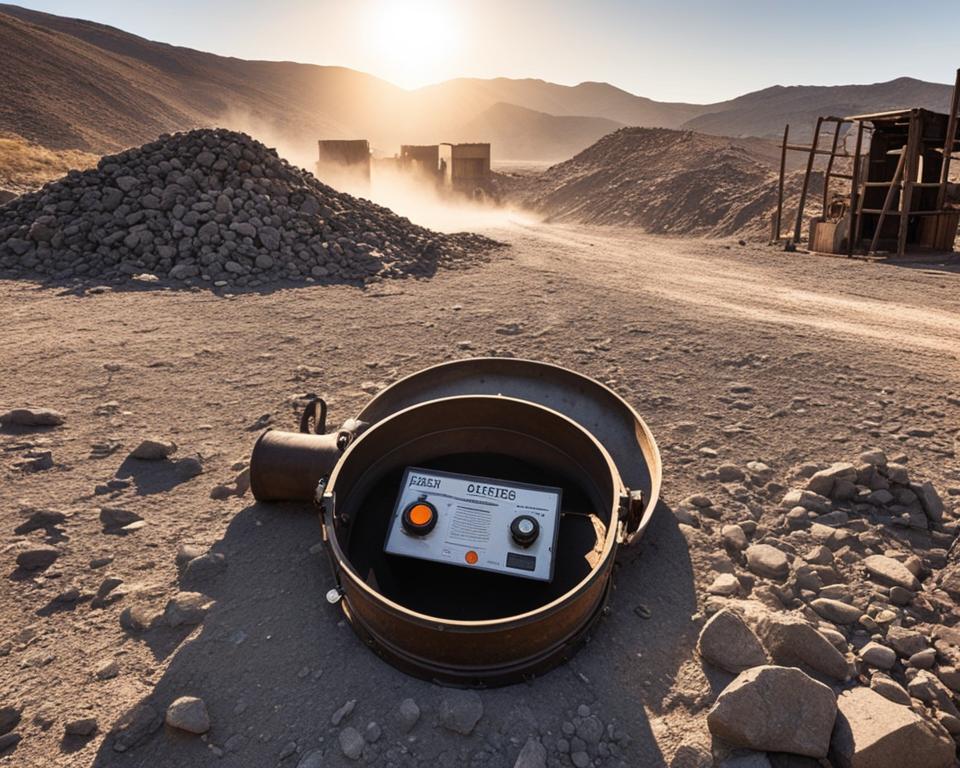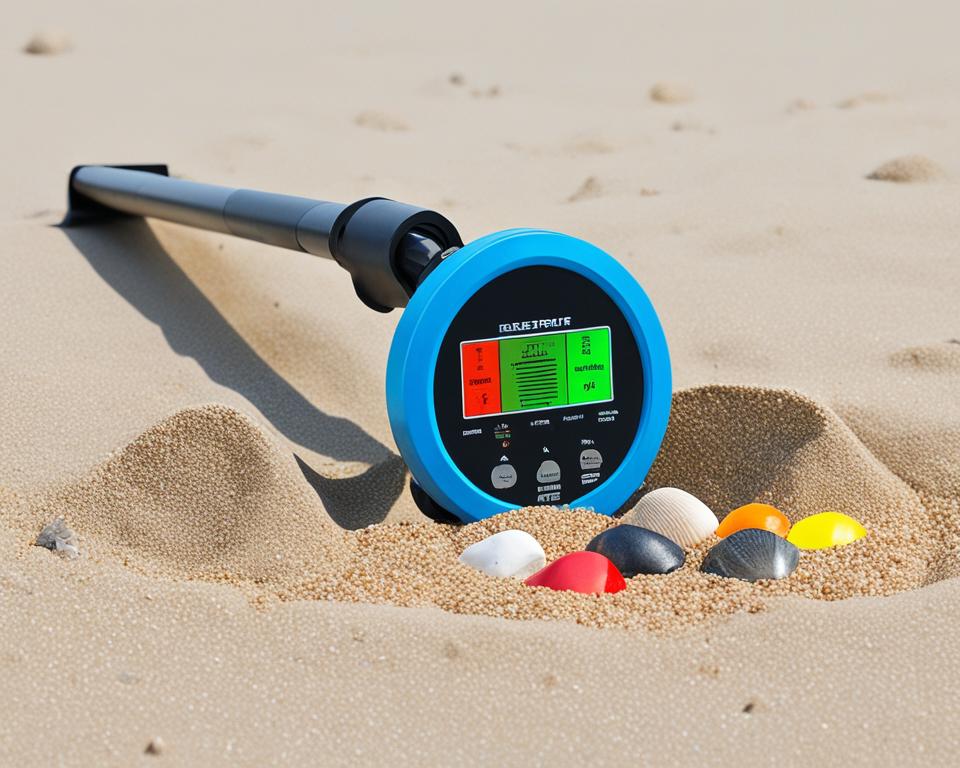
Gold prospecting with a metal detector can be a thrilling and rewarding hobby. Imagine the excitement of discovering a hidden gold nugget or uncovering a treasure trove of gold coins. With the right equipment, techniques, and knowledge, you can increase your chances of finding precious gold with a metal detector.
Key Takeaways:
- Research and practice are essential before searching for gold nuggets with a metal detector.
- Gold is often found in dredge tailing piles and placer deposits, so researching past gold locations is vital.
- Choosing the right metal detector for gold hunting is crucial, with different types designed for specific purposes.
- Proper techniques such as slow sweeping, overlapping coil sweeps, and digging all targets can maximize your chances of finding gold.
- Observation, recording, and systematic search techniques like chaining and gridding can enhance your gold prospecting efforts.
The Best Metal Detectors for Gold Nugget Hunting
When it comes to finding gold nuggets, having the right metal detector can make all the difference. Experts recommend using top-notch metal detectors specifically designed for gold hunting. These detectors are equipped with advanced features that cancel out mineralization and have high sensitivity to small gold nuggets.
One of the top choices for gold prospecting is the Minelab GPZ 7000. This metal detector utilizes advanced technologies such as Zero Voltage Transmission (ZVT) to provide exceptional depth and sensitivity. It can detect even the smallest gold nuggets buried deep in the ground.
Another popular gold hunting metal detector is the Garrett AT Gold. It is specifically designed to handle highly mineralized environments and offers excellent sensitivity to small gold nuggets. The AT Gold is also waterproof, allowing you to search for gold in shallow water bodies.
The XP DEUS is a versatile metal detector suitable for various types of treasure hunting, including gold prospecting. It offers exceptional target separation and sensitivity, allowing you to detect even the tiniest gold nuggets. Additionally, its wireless design provides unmatched convenience during your prospecting adventures.
If you’re looking for a more compact and lightweight option, the Fisher Gold Bug and Fisher Gold Bug-2 are highly recommended. These metal detectors are known for their sensitivity to small gold pieces and their ability to handle mineralized ground conditions effectively.
In summary, the best metal detectors for gold nugget hunting include the Minelab GPZ 7000, Garrett AT Gold, XP DEUS, Fisher Gold Bug, and Fisher Gold Bug-2. These detectors are designed to enhance your chances of finding gold nuggets by canceling out mineralization and maximizing sensitivity. Remember, investing in a high-quality metal detector is a crucial step towards successful gold prospecting.
Where to Find Gold Nuggets
Gold nuggets are typically found in areas where gold has been discovered in the past. This includes dredge tailing piles and placer deposits. Many people associate finding gold with states like California, Arizona, and Alaska due to their gold rush history. However, gold has been found all across the United States. To increase your chances of finding gold, it is important to research the gold-producing areas in your state, consult books and resources on prospecting, and check with local geological surveys to understand the occurrence of gold in specific locations.
Choosing the Right Metal Detector for Gold Prospecting
When it comes to gold prospecting, selecting the right metal detector can significantly impact your success in finding those sought-after gold nuggets. Consideration of several key factors is crucial to make an informed decision.
Type of Soil and Mineralization
The type of soil and mineralization in your target area should be a primary consideration when choosing a metal detector for gold prospecting. Certain detectors perform better in highly mineralized soil conditions, such as those commonly found in gold-rich areas. Very Low Frequency (VLF) detectors are known for their sensitivity to small gold nuggets and their ability to handle mineralized soil effectively.
Budget and Experience Level
Your budget and experience level also play crucial roles in the selection process. Setting a budget beforehand helps narrow down your options and ensures you don’t go beyond what you’re comfortable spending. Additionally, consider your level of experience with metal detecting. If you’re a beginner, opting for a user-friendly model with preset modes can help streamline your learning process.
Detector Features
When evaluating metal detectors, pay attention to features such as adjustable ground balance and discrimination settings. Adjustable ground balance allows you to adapt to various soil conditions and mineralization levels, enhancing your chances of finding gold. Discrimination features help filter out unwanted targets, such as trash or iron, allowing you to focus on valuable gold signals.
“Choosing a metal detector that matches the soil conditions, mineralization, and your experience level is crucial for successful gold prospecting.” – John Smith, Metal Detecting Expert
Comparison Table of Gold Hunting Metal Detectors
| Metal Detector | Type | Price Range | Features |
|---|---|---|---|
| Minelab GPZ 7000 | Pulse Induction (PI) | $7,000 – $8,000 | High sensitivity, deep detection |
| Garrett AT Gold | Very Low Frequency (VLF) | $600 – $700 | Adjustable ground balance, excellent discrimination |
| XP DEUS | Very Low Frequency (VLF) | $1,500 – $2,000 | Lightweight, wireless, customizable settings |
Table: A comparison of popular gold hunting metal detectors based on type, price range, and key features.
Remember, choosing the right metal detector for gold prospecting involves careful consideration of factors such as soil conditions, your budget, and experience level. Take your time to research and compare different models before making a decision. By selecting the appropriate metal detector, you’re one step closer to uncovering those precious gold nuggets.
Metal Detecting Techniques for Finding Gold
To improve your chances of finding gold with a metal detector, it is important to use proper techniques. Here are some valuable tips for finding gold nuggets with a metal detector and maximizing your gold prospecting:
- Slow and deliberate sweep speed: When sweeping the metal detector over the ground, maintaining a slow and deliberate speed allows for better target identification and increases the chances of detecting small gold nuggets. Rushing through the process may result in missing potential gold signals.
- Keep the coil parallel to the ground: Keeping the search coil parallel to the ground surface ensures maximum depth and sensitivity. This technique allows the detector to pick up even the faintest signals from buried gold targets.
- Overlap your coil sweeps: Overlapping your coil sweeps is crucial for covering the entire search area effectively. By overlapping each sweep, you reduce the chances of missing potential gold targets that may be hidden within the gaps.
- Dig all targets: One of the golden rules of metal detecting for gold is to dig all targets. By not discriminating against any signals, you increase the chances of uncovering gold nuggets that may have been overlooked by others. Remember, gold can sometimes register as a lower target ID, so it is important to dig all signals that could potentially be gold.
- Pinpointing the target: Once you’ve detected a signal, using the pinpointing feature on your metal detector allows for more accurate target location. This helps prevent unnecessary digging and ensures a more efficient gold prospecting experience.
- Proper recovery techniques: When retrieving the target, it is essential to use proper recovery techniques. Using a plastic shovel or your hands instead of metal tools minimizes the risk of damaging any potential gold nuggets. Handle the target with care to preserve its shape and integrity.
By applying these metal detecting techniques for finding gold, you can increase your chances of success and maximize your gold prospecting endeavors.
“By applying these metal detecting techniques for finding gold, you can increase your chances of success and maximize your gold prospecting endeavors.”
Understanding How Gold Objects are Detected
Gold objects, whether naturally occurring nuggets or man-made gold objects, can vary in size, shape, and alloy. When using a metal detector to locate gold, the size and shape of the gold object can affect the target identification (ID) and audio tone produced by the detector.
Smaller gold objects, such as earrings or small pieces of naturally occurring gold, may display lower target ID numbers and produce lower audio tones. On the other hand, larger gold objects, like men’s rings, may show higher target ID numbers and produce louder sounds.
The alloy composition of the gold can also influence the readings obtained from the metal detector. Different gold alloys can generate visual and audio indications that vary from those of pure gold. Therefore, it is essential to understand how different gold alloys may affect the detector’s response and familiarize oneself with the specific characteristics of various gold alloys.
“Understanding the target ID and audio tone variations for different gold objects can significantly enhance the effectiveness of gold detection, enabling prospectors to differentiate between small and large gold items and distinguish gold from other metallic targets.” – Gold Prospecting Expert
To achieve accurate and consistent readings when detecting gold, it is crucial to calibrate the metal detector settings according to the target ID and audio tone responses expected for different gold objects. This calibration process can be refined by practicing with known gold items to establish a reference point for future gold prospecting adventures.
The Importance of Coil Selection in Gold Prospecting
When it comes to gold prospecting, choosing the right metal detector coil is crucial for maximizing your chances of finding gold. The type of coil you use can greatly impact your success in detecting gold nuggets. Different coils are designed for different ground conditions and sensitivity to gold, so it’s important to select a coil that best suits your prospecting needs.
Coil selection for gold prospecting involves considering factors such as ground conditions, target size, and detection depth. Larger coils are ideal for covering more ground and detecting larger gold nuggets, while smaller coils offer increased sensitivity to smaller gold pieces.
If you’re searching for gold in areas with highly mineralized soil, a coil with good ground balance capabilities is essential. Some coils are specifically designed to handle high mineralization and can eliminate interference, allowing you to detect gold more accurately.
Choosing the right metal detector coil for gold hunting also depends on the size of the gold you’re targeting and the sensitivity of the coil. If you’re searching for small gold pieces, a coil with high sensitivity is recommended. These coils can detect even the smallest gold nuggets, improving your chances of success.
However, it’s important to note that larger coils may sacrifice a bit of sensitivity to smaller gold pieces in exchange for greater depth detection. So, if you’re prospecting in areas with larger nuggets or deeper deposits, using a larger coil can be advantageous.
To maximize your gold prospecting potential, it’s also helpful to have a selection of coils for different ground types and detecting conditions. This allows you to adapt to various environments and increase your chances of finding gold.
Benefits of Choosing the Right Metal Detector Coil for Gold Prospecting
“Selecting the right coil enhances your ability to find gold nuggets efficiently and effectively. A well-matched coil improves target detection and discrimination, allowing you to focus on valuable gold targets and avoid wasting time on false signals.”
By carefully considering the ground conditions, target size, and detection depth, you can choose the right metal detector coil that aligns with your gold prospecting goals. Whether you’re searching for small gold nuggets in mineralized soil or targeting larger, deeper deposits, selecting the appropriate coil can significantly improve your chances of success.
With the right coil in hand, you’ll be well-equipped to navigate various gold-bearing environments and uncover hidden treasures. So, take the time to research and understand your specific prospecting needs, and choose a coil that will help you in your gold hunting endeavors.
Comparing Coil Sizes and Sensitivities
| Coil Size | Ground Coverage | Sensitivity to Small Gold Pieces | Depth Detection |
|---|---|---|---|
| Small Coil | Limited | High | Shallow |
| Medium Coil | Moderate | Moderate | Moderate |
| Large Coil | Extensive | Lower | Deeper |
Techniques for Maximizing Gold Recovery
To ensure maximum gold recovery, it is crucial to dig all targets and thoroughly search the detected area. Proper digging techniques play a vital role in uncovering elusive gold nuggets. When approaching a target, use a plastic shovel or your hands to avoid damaging any potential gold. Carefully scrape the rock material out of the hole and examine if the target has moved.
Being productive and selective in your metal detecting areas can significantly improve your chances of finding gold. Choose specific locations that are likely to have a high gold content, such as dredge tailing piles and placer deposits. Clear the site of debris and grid the area to ensure thorough coverage.
Proper Digging Techniques
- Scraping: Use a plastic shovel or your hands to carefully scrape away rock material from the target area. This method helps prevent potential damage to any hidden gold.
- Testing Movement: After scraping, test if the target has moved by checking if it is still present in the hole or has shifted elsewhere.
Selective Searching
- Location Research: Focus on specific locations that have a history of gold production, such as known gold-bearing areas, old mining sites, or areas with geological indicators of gold deposits.
- Clearing Debris: Remove any obstructions or debris from your search area to enhance your metal detecting experience and increase the chances of discovering gold.
- Grid Coverage: Systematically grid the area by covering it in a structured manner, moving in straight lines and overlapping your sweeps. This ensures comprehensive coverage and leaves no potential gold undiscovered.
Proper Digging and Retrieval Methods for Gold
| Technique | Description |
|---|---|
| Scraping | Using a plastic shovel or your hands to carefully scrape away rock material from the target area, minimizing the risk of damaging any potential gold. |
| Testing Movement | After scraping, assess if the target has moved by checking if it is still present in the hole or has been displaced. |
| Location Research | Focusing on specific gold-bearing areas and areas with geological indicators of gold deposits to increase the chances of successful metal detecting. |
| Clearing Debris | Removing obstructions or debris from the search area to improve metal detecting accuracy and effectiveness. |
| Grid Coverage | Systematically covering the search area in a structured manner, ensuring every section is thoroughly scanned and leaving no stone unturned. |

The Importance of Observation and Recording
Observing and recording your metal detecting experiences can greatly enhance your gold prospecting efforts. By documenting important details, you can establish a valuable archive of information that will aid in future expeditions and help you make more informed decisions when it comes to detecting sites and techniques.
Keeping accurate records of your gold finds and metal detecting sites is crucial in understanding patterns and trends. This information will enable you to identify areas with high gold potential and target them specifically for future searches. Each find contributes to your knowledge base, allowing you to refine your approach and increase your chances of uncovering more gold nuggets.
GPS Coordinates and Specifics
One of the most important aspects of recording your metal detecting experiences is documenting the GPS coordinates of your finds and detecting sites. This information helps you remember specific locations and track your progress over time. Whether you’re using a handheld GPS device or a smartphone app, recording precise coordinates ensures that you can revisit successful areas or avoid revisiting unproductive spots.
“Recording the size and type of gold found, geological indicators, and the equipment used provides valuable insights for future prospecting trips.”
Additionally, it’s essential to record the size and type of gold you find. Not only does this help you assess the quality of your discoveries, but it also allows you to understand the characteristics of gold in different locations. By documenting specific geological indicators such as rock formations, soil types, and nearby water sources, you can start recognizing patterns and narrowing down the environments where gold is most likely to be found.
Equipment and Techniques
Another aspect of observation and recording in gold prospecting is keeping detailed notes about the equipment and techniques used during each detecting session. This information helps you evaluate the performance of your metal detector, coil, and other tools. By logging the success or failure of different equipment configurations and techniques, you can make informed decisions about which settings to adjust, which targets to prioritize, and which areas to focus on during future expeditions.
Furthermore, recording any additional observations about the environment can provide valuable insights. Take note of any signs of previous metal detecting activities, such as disturbed soil or detectable trash left behind. These signs can indicate that others have already targeted the area, potentially diminishing your chances of finding significant quantities of gold. Conversely, identifying areas with minimal signs of past activity may lead you to less-explored sites with untapped gold potential.
| Benefits of Observation and Recording | Examples |
|---|---|
| Track your progress and identify productive sites | Create a map of your successful detecting locations. |
| Understand the characteristics of gold in different environments | Record the size and type of gold found in different geologic formations. |
| Evaluate the performance of your equipment and techniques | Note the settings and tools used when you make significant finds. |
| Identify areas with minimal signs of past activity | Take note of undisturbed sites that may hold untapped gold potential. |
By embracing the importance of observation and recording, you can elevate your gold prospecting endeavors to new levels of success. So grab your metal detector, pack your recording tools, and embark on a journey of discovery as you unravel the hidden treasures waiting to be found.
Metal Detecting on Salt Lakes for Gold
Salt lakes can be fruitful locations for gold prospecting with a metal detector. Due to the difficulty of detecting on salt lakes, many areas remain unexplored, leaving potential for gold discoveries.
When metal detecting on salt lakes, target areas such as:
- Old dryblowing heaps
- Old diggings
- Machine scraping
- Valley floors downstream from old mines
Clear the site of debris and metal trash, and utilize the appropriate coils for salt lake conditions.

The Importance of Chaining and Gridding for Gold Prospecting
Chaining and gridding are systematic search techniques that can greatly increase your chances of finding gold. When it comes to gold prospecting, maximizing gold recovery with systematic search techniques is essential. Let’s explore how chaining and gridding can enhance your gold hunting endeavors.
Chaining for Gold Prospecting
Chaining involves methodically searching a specific area by following a pattern. Whether you’re exploring a riverbed, a stream, or a patch of land, chaining ensures no spots are missed in your quest for gold. By systematically covering the entire area, you significantly improve your chances of uncovering hidden gold nuggets and flakes. This technique allows you to work through an area in a structured and organized manner, increasing the efficiency of your prospecting efforts.
Gridding and Its Benefits
Similar to chaining, gridding is a highly effective technique for gold prospecting. Gridding involves dividing a target area into smaller sections and using different coils in each section. This allows you to increase the sensitivity of your metal detector to small gold pieces. By using various coils, you can cover the area with different levels of sensitivity, maximizing your chances of detecting even the tiniest specks of gold. Gridding helps ensure that no gold is left undiscovered within the search area, leaving no chance for the next prospecting enthusiast.
“Chaining and gridding are systematic search techniques that can greatly increase your chances of finding gold.”
Implementing both chaining and gridding techniques in your gold prospecting routine helps you achieve a comprehensive and thorough search method. By systematically covering the ground with a patterned approach, you leave no stone unturned and no gold nugget undiscovered. Through the meticulous application of these techniques, you maximize your gold recovery and increase the overall success of your prospecting endeavors. So, grab your metal detector, embrace the art of chaining and gridding, and embark on your journey to uncover the gold awaiting discovery.
| Technique | Description |
|---|---|
| Chaining | Methodically searching a specific area by following a pattern to ensure thorough coverage. |
| Gridding | Dividing a target area into smaller sections and using different coils in each section to increase sensitivity. |
Conclusion
Gold prospecting with a metal detector can be a rewarding and exciting hobby. By conducting thorough research, selecting the right equipment, and using proper techniques, you can increase your chances of finding gold nuggets. Remember to always dig all targets, observe and record your findings, be systematic in your search, and enjoy the thrill of uncovering hidden treasures with your metal detector. Happy hunting!
Throughout this article, we have explored the various aspects of gold prospecting with a metal detector. We have discussed the importance of mastering coin hunting and practicing target burying in a test garden to improve your skills. We also highlighted the top metal detectors recommended for gold nugget hunting, including the Minelab GPZ 7000, Garrett AT Gold, and XP DEUS.
We delved into the locations where gold nuggets can typically be found, such as dredge tailing piles and placer deposits, and emphasized the importance of researching gold-producing areas and consulting geological surveys. We also discussed the factors to consider when choosing the right metal detector for gold prospecting, including soil type, mineralization, budget, and experience level.
Furthermore, we provided valuable insights into the techniques for maximizing gold recovery, including proper digging and retrieval methods, as well as the significance of observation and recording in enhancing your prospecting efforts. We touched on metal detecting on salt lakes as a potential gold prospecting area and highlighted the systematic search techniques of chaining and gridding to increase your chances of finding gold.
FAQ
How do I find gold with a metal detector?
Gold prospecting with a metal detector requires time, research, and the right equipment. It is recommended to master coin hunting and practice burying targets in a test garden to hone your skills. Additionally, researching the locations where gold has been found in the past is essential.
What are the best metal detectors for gold nugget hunting?
Some of the top metal detectors recommended by experts for finding gold nuggets are the Minelab GPZ 7000, Garrett AT Gold, and XP DEUS. The Fisher Gold Bug and Fisher Gold Bug-2 are also popular options for gold prospecting.
Where can I find gold nuggets?
Gold nuggets are typically found in areas where gold has been discovered in the past, such as dredge tailing piles and placer deposits. Researching gold-producing areas in your state, consulting books and resources on prospecting, and checking with local geological surveys can help you identify potential locations.
What factors should I consider when choosing a metal detector for gold prospecting?
When selecting a metal detector for gold prospecting, it is important to consider factors such as the type of soil and mineralization in your target area, as well as your budget and level of experience. Very low frequency (VLF) detectors are sensitive to small gold nuggets, while pulse induction (PI) detectors are designed for detecting larger gold nuggets at greater depths.
What are some techniques for finding gold with a metal detector?
To improve your chances of finding gold with a metal detector, it is important to use proper techniques. This includes using a slow and deliberate sweep speed, keeping the coil parallel to the ground, and overlapping your coil sweeps to cover the entire area. It is also recommended to dig all targets and not discriminate against potential gold signals.
How are gold objects detected by a metal detector?
Gold objects, whether naturally occurring nuggets or man-made gold objects, can vary in size, shape, and alloy. This can affect the target ID and audio tone when metal detecting. Small gold objects may display lower target ID numbers and lower audio tones, while larger gold objects may show higher target ID numbers and louder sounds. The alloy of the gold can also affect the detector readings.
How does coil selection impact gold prospecting?
The type of coil you use with your metal detector can greatly impact your success in finding gold. Different coils are designed for different ground conditions and sensitivity to gold. It is important to select a coil that matches the ground conditions and the size of gold you are searching for.
What are some techniques for maximizing gold recovery with a metal detector?
To ensure maximum gold recovery, it is crucial to dig all targets and thoroughly search the detected area. Use proper digging techniques, such as scraping the rock material out of the hole and testing if the target has moved. When retrieving the target, use a plastic shovel or your hands to avoid damaging any potential gold.
How important is observation and recording in gold prospecting?
Observing and recording your metal detecting experiences can greatly enhance your gold prospecting efforts. Keep records of GPS coordinates, the size and type of gold found, the geology and indicators of the area, the type of metal detector and coil used, and any other relevant information. This data will help you build knowledge and identify patterns for future prospecting trips.
Can salt lakes be fruitful locations for gold prospecting with a metal detector?
Yes, salt lakes can be fruitful locations for gold prospecting. Many areas on salt lakes remain unexplored, leaving potential for gold discoveries. Target areas such as old dryblowing heaps, old diggings, machine scraping, or valley floors downstream from old mines. Clear the site of debris and metal trash and utilize appropriate coils for salt lake conditions.
How important are chaining and gridding for gold prospecting?
Chaining and gridding are systematic search techniques that can greatly increase your chances of finding gold. Chaining involves methodically searching a specific area by following a pattern, ensuring no spots are missed. Gridding is similar but involves using different coils in the same area to increase sensitivity to small gold pieces. These techniques maximize gold recovery and leave no gold for the next person.
Source Links
- https://www.gold-prospecting-wa.com/metal-detecting.html
- https://www.metaldetector.com/blogs/new_blog/gold-nugget-hunting-with-a-metal-detector
- https://highplainsprospectors.com/blogs/news/faq-what-does-gold-come-up-as-on-a-metal-detector

Meet Ryan Conlon, the passionate owner and driving force behind Pan for Treasure.
With an unwavering love for the art of gold panning, Ryan has transformed his enthusiasm into a thriving community hub for fellow treasure seekers. [email protected]
A seasoned gold panning enthusiast, Ryan’s journey began with a simple pan and a dream, evolving into a deep appreciation for the history, geology, and thrill of uncovering precious metals.


